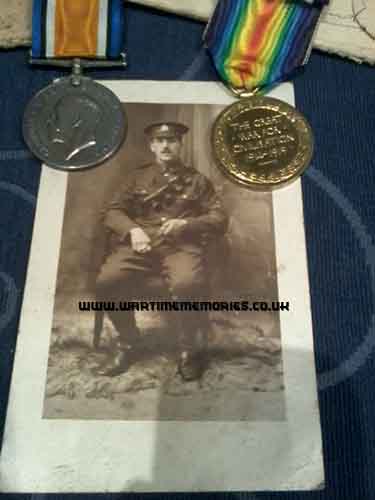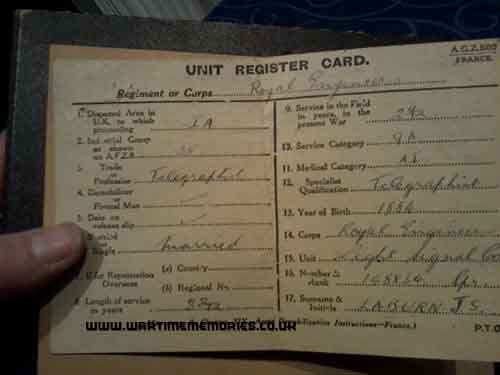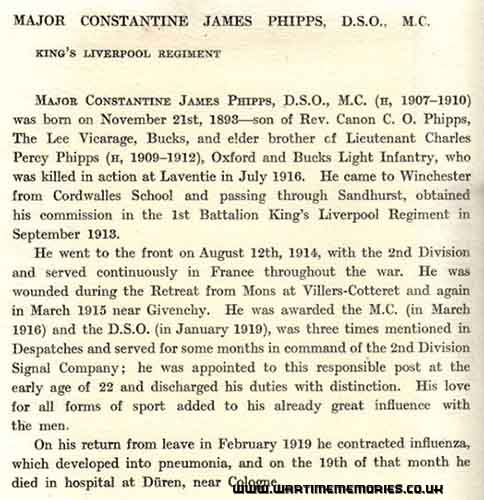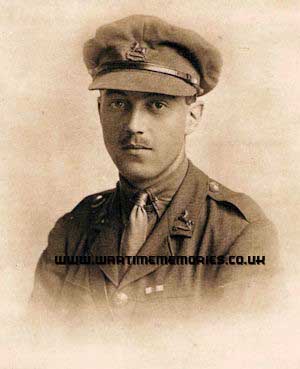Additions will be checked before being published on the website and where possible will be forwarded to the person who submitted the original entries. Your contact details will not be forwarded, but they can send a reply via this messaging system.
please scroll down to send a message
Spr. John Small Laburn
British Army 7th Divisional Signals Company Royal Engineers
from:Bellefield Avenue, Dundee
At the outbreak of World War I on July 28 1914, the Austro-Hungarian Empire invaded Serbia, beginning a world war that would last four years, result in millions of casualties and change the world irrevocably. Jack Laburn was a GPO telegraphist who lived at 8 Bellefield Ave. Dundee, Angus with his wife Eva (nee Bell: funny if you are a telegraphist!) and his baby son Jimmy (born in May 1914). Jack was born Oct 21st 1884 in Dundee to John & Margaret Laburn, the 2nd of 5 children. He attended the Harris Academy and had a good job as Post Office Telegraphist & later as Post Office Supervisor. Jack married Eva Laburn, and they had son James Bell Laburn (May 30th 1914) & later Eva Margaret Laburn.
Jack joined up aged 32 in December 1915, after the 1915 Registration Act & Derby Group Scheme made it clear that conscription was just round the corner. He was placed as a Telegraphist Sapper with 2nd Signal Company, Light Signal Corps. Royal Engineers (although only named the Light Division in 1919). I presume he trained at Chatham Training Depot, Kent with his regiment the Royal Engineers, finished basic training & was posted January 1916. He saw action in Flanders, on the Western Front in France throughout 1916-1917.
Whilst on Active Service Overseas Jack sent postcards home to his son Jimmy from:
Postcard: July 10th 1916 Flanders/Western Front (Photo of artillery-wrecked villa taken in 1914) Field post office D7BOC9: This will give you some idea of the havoc wrought by the Huns big guns. I passed this place some weeks ago. Am quite well & hope you are ditto. Best Love J L 10th July No Letter today yet. - FPO D7. postmark. (I am no expert on FPOs, but D7 appears to indicate 7th Division HQ, so he may have initially been with 7th Div Signal Coy.)
Postcard: Frevent 26th April 1917 (British Expeditionary Force: Casualty Clearing station at Frevent. Was he wounded or working?? NB He doesn t say he s OK!) - Dear Jimmy, I havent had a letter from Mamma for two or three days so I dont have anything to write about. Many thanks for your last letter. I am very glad to know you are looking after Mamma and Aunt Ruth. We are having a day of rain after some nice mild days. I hope you are all quite fine. Kiss Mamma for me, Love to you both from Daddy.
Newspaper report: Volunteers held up, factories out & shipyards supplies hampered. PO mail delivering train from Perth. British Gazette
Postcard: Hautment: Rue de Maubeuge 20.11.1918 - En Route for Germany walking all the way across Belgium, should cross border in next few days trek. Weather not too bad am OK & hope you are both ditto Best Love JL - Rue de Maubeuge was probably the road of that name in the town of Hautmont on the River Sambre.
Postcard: Koln am Rhein 18th Feb 1919 Picture of Deutscher Ring, palace & fountains - Dear Jimmy, What do you think of this pretty place? I got your nice letter this morning and am glad to know you are well. I hope you are looking after Mamma all right? Please write again soon. Kisses from Daddy.
Bruxelles book of cards; Namur book of cards; Spa Korsaal book of cards: German Imperial Army Headquarters was in Spa in occupied Belgium, 5 x Beautifully embroidered cards: Flowers from France, 1917 embroidered in allied flag colours Richt is might, embroidered in allied flag colours Message to my wife, Remembrance.
Jack joined 2nd Signal Coy from signal depot (presumably Abbeville) 29th Sept 1916, at which time the Company HQ was at a village called Couin in the Somme sector, where they had been since August 21st after 2nd Division relieved the Guards Division. On 12th October he got a pay rise, becoming a Telegraphist (Office). By this time, the Company HQ had moved 15km south to Hedauville. Now Jack was an office telegraphist it could mean that he was probably assigned to work in the Company HQ section although it is possible that he could also have still been posted from time to time to one of the 3 Brigade sections, whose HQs were closer to the front line. The way army signalling was organised, the Royal Engineers Divisional Signal Companies comprised 4 main sections: HQ and No.1 Section was responsible for communications to the rear between Division HQ and higher echelons, and forward to the 3 Brigades of the Division and the Divisional artillery. No.2, 3 and 4 Sections were based at Brigade HQs and were responsible for maintaining links to the front line. Front line signalling was the responsibility of the infantry, not the Royal Engineers. Later in the war, a wireless section was added as were separate sections to link with the Royal Artillery and Machine Gun Corps. Jack might have seen some action round about at Cambrai, Baupaume & Sambre, judging from his letters & cuttings.
On 20th November 1918, the Company HQ was at Maubeuge and it marched through Belgium, Naumur, into Germany, with the last of the Cavalry units, arriving at Duren near Cologne on 15th December as part of the BEF Occupying Force. On a rather sad note, the Company Commander, Major C.J. Phipps, who had spent most of the war with unit, died of the flu in February 1919 and was buried in Duren. (see Picture & obit)
On 20th April 1919, 2nd Division became the Light Division, and the 2nd Signal Company became Light Division Signal Company. Jack returned to Britain in April 1919 to RE base at Chatham, Kent and was discharged into the Reserves in May 1919 returning to his home, 8 Bellefield Ave. Dundee from No 1 Dispersal Unit Kinross with total pay of £20 15S 6d and a Military greatcoat (worth £1 if returned to army). He was awarded 2 medals: Victory medal & British War medal for service abroad. According to his granddaughter Jack never talked about his war, he returned to his wife & children in Dundee and continued his life as Post Office supervisor. Jack died in 1956 aged 72 in Dundee. Angus Scotland, he now has four proud great grandchildren.
Below is Transcript of Newspaper cutting found with Jacks effects: I wonder if he was among the brave signallers mentioned?
A great Fight: British Heroism near Cambrai (1917) An account of the operations of the 47th London Territorial Division, the 2nd Division & the 56th London Territorial Division in the neighbourhood of Bourlon & Mouvres on November 30th last which we have received from an authoritative source, states that the story of the fighting is so brimful of heroism that it deserves to take its place in English history for all time. The most determined attacks of four German divisions, with three other German divisions to support were utterly crushed by the unconquerable resistance of the three British Divisions in line. After a bombardment of great intensity the German offensive began shortly after 9am, large numbers of the enemy being seen coming over the ridge to the west of Bourlon Wood against the junction of the 2nd and 47th Divisions. Our artillery barrage caught this advance but in spite of their losses the German infantry pressed on. The left of the London Territorials was being forced back. Four posts on the right of the 2nd division were wiped out. The situation was critical. As the enemy's infantry appeared over the crest of the hill, however they were engaged with direct fire by our field artillery. Machine guns in position in a sunken road south-west of Bourlon Wood and in the sugar factory in the Baupaume-Cambrai road swept their advancing lines. The survivors of the 2nd Divisions posts succeeded in getting to shell holes farther back and held out. While the artillery of both British Divisions maintained a constant and accurate fire, rifle, Lewes gun and machine gun fire inflicted enormous losses on the enemy, held up his advance and eventually drove him back after three hours hard fighting.
A REARGUARDS SACRIFICE
Farther west the enemys advance broke upon the 17th Battalion Royal Fusiliers, 2nd Division which was in the act of withdrawing from an advanced sap & trench, judged too exposed to be maintained in the face of so powerful an attack. Owing to the enemy being concealed in some dead ground the attack developed with unexpected speed and the company holding the advanced position was ordered to leave a rear-guard to cover the withdrawal of the remainder. Captain W.N. Stone, who was in command of the company sent back three platoons and himself elected to remain with the rear-guard along with Lieutenant Benzecry. This rear-guard, assisted by our machine guns held off the whole of the German attack until the main position of the 17th Battalion Royal fusiliers was fully organised and THEY ALL DIED TO A MAN WITH THEIR FACES TO THE ENEMY. Before midday the enemy again attacked on the whole front of the right brigade of the 2nd division but was once more hurled back with great slaughter. Early in the afternoon large messes of the enemy attacked on a front of nearly a mile with Bourlon Wood and on the left of the 47th Division a gap was formed between the 1st and 6th Battalions and the 1/15th Battalions London Regiments. This gap was closed by the prompt action of the officers commanding these battalions who with a reserve company and the staffs of their respective headquarters, including runners, signallers, orderlies and cooks led immediate and successful attacks. The garrisons of the three posts on the front of the 2nd Division fell fighting to the last and when the line at this point was restored such a heap of German dead lay in and around the posts it was impossible to found the bodies of our own men. In this locality five other posts held by a company of the first Battalion Royal Berkshire Regiment repulsed all the enemys attacks and maintained themselves until our reinforcements had restored the situation. The casualties of this company were 46. They claim to have killed over 500 of the enemy. During the afternoon a strong hostile attack was made upon the 141st Brigade on the right of the 47th Division. The enemy was again hurled with heavy losses. A distinctive feature of the defence was the gallantry of the Lewis Gunners, who when the attack was seen to be beginning, ran out with their guns in front of our line and from positions of advantage in the open mowed down the advancing German Infantry. The ATTACK AT MOEVRES Similar events were happening meanwhile on the left of the 2nd Division and on the right of the 56th Division. I this fighting in the Mouvres area Captain AMC Mc Ready Diarmid of the 17th Battalion Middlesex Regiment greatly distinguished himself. When the enemy had penetrated some distance into the position and the situation was extremely critical he led his company forward through a very heavy barrage and drove the Germans back at least 500 yards. On the following day the officer again lead a bombing attack against a party of Germans who had broken in against our positions and pressed those back 500 yds. On the following day this officer again led a bombing attack against a party of Germans and pressed them back 300 yards himself killing 60 of the enemy. The Battle of Cambrai ranks as one of the most thrilling episodes of the whole war. Tanks at last came into their kingdom. The notion that the Hindenburg Line was impregnable was exploded.



